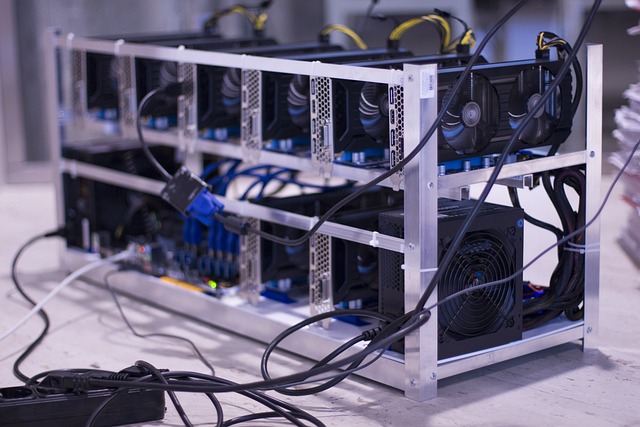DeFi Innovations: From Yield Farming to NFTs
DeFi Innovations: From Yield Farming to NFTs

Understanding the Evolution of Decentralized Finance
Decentralized finance, or DeFi for short, has been making waves in the world of finance over the past few years. Unlike traditional finance, which relies heavily on centralized institutions like banks and regulators, DeFi operates on a peer-to-peer basis using blockchain technology. This innovative approach has brought about a paradigm shift, providing individuals with greater control and autonomy over their financial decisions.
One of the key drivers behind the evolution of DeFi is its ability to offer financial services without the need for intermediaries. In the traditional financial system, transactions are often subject to lengthy approval processes and high fees. However, with DeFi, users can access a wide range of financial products and services instantaneously and at a fraction of the cost. This democratization of finance has opened up a world of possibilities for individuals who were previously overlooked or excluded by the traditional banking system.
Exploring the World of Yield Farming and its Potential
Yield farming has taken the decentralized finance (DeFi) world by storm, promising lucrative rewards for participants. On the surface, it seems like a simple concept – users provide liquidity to a decentralized exchange or lending platform and earn tokens in return. However, the potential of yield farming goes far beyond just earning passive income. It has opened up new avenues for users to actively engage in DeFi protocols, experiment with different strategies, and contribute to the growth and sustainability of the ecosystem.
One of the key benefits of yield farming is the ability to earn high interest rates on locked-up assets. By providing liquidity to DeFi protocols, users can earn not only the trading fees generated by the platforms but also the native tokens of the protocols themselves.

Unleashing the Power of Non-Fungible Tokens (NFTs)
Non-Fungible Tokens (NFTs) have taken the world by storm, revolutionizing the concept of digital ownership. These unique tokens have grabbed the attention of artists, collectors, and investors alike, offering a new way to buy, sell, and trade digital assets. Unlike cryptocurrencies such as Bitcoin or Ethereum, NFTs cannot be exchanged on equal terms with other tokens because each NFT is distinct and holds its own value. This inherent uniqueness is what makes NFTs stand out in the digital world, providing a way to authenticate and verify ownership of digital creations.
One of the key benefits of NFTs is their ability to empower creators and artists. In traditional systems, artists have often struggled to monetize their digital work, as it can be easily copied, shared, and pirated without their consent. However, NFTs change the game by allowing artists to mint their creations as unique tokens, ensuring that each piece is one-of-a-kind and can be sold as a scarce digital asset. This opens up a whole new world of possibilities for artists, enabling them to earn value for their digital art, music, videos, and even virtual real estate. With NFTs, creatives can tap into a global market and connect directly with fans and collectors, eliminating the need for middlemen and traditional gatekeepers.
The Rise of Decentralized Exchanges and their Impact on DeFi
Decentralized exchanges have been gaining significant traction in the world of DeFi, revolutionizing the way cryptocurrency trading takes place. Unlike traditional exchanges that rely on central authorities to facilitate transactions, decentralized exchanges operate on blockchain networks, ensuring transparency, security, and user control. These exchanges allow individuals to directly trade digital assets without the need for intermediaries, empowering users to have full ownership and control over their funds. This shift towards decentralized exchanges has had a profound impact on the DeFi ecosystem, fostering a more inclusive and accessible financial landscape.
One of the key advantages of decentralized exchanges is their ability to tackle the issues of trust and security that have plagued the traditional financial system. By leveraging blockchain technology and smart contracts, these exchanges eliminate the need for users to deposit their funds into a centralized custody account, reducing the risk of hacks and theft. Instead, trades are executed peer-to-peer, with the transactions being directly settled on the blockchain. This not only enhances the security of transactions but also eliminates the reliance on intermediaries, making the process faster and more efficient.

Exploring the Role of Decentralized Lending in the DeFi Ecosystem
Decentralized lending plays a crucial role in the rapidly evolving world of decentralized finance (DeFi). By allowing individuals to borrow and lend digital assets directly from one another, without the need for intermediaries like banks, decentralized lending platforms enable greater financial inclusivity and accessibility.
One of the key benefits of decentralized lending in the DeFi ecosystem is the ability to earn interest on idle assets. Users can lend out their digital tokens and earn passive income in the form of interest payments. This opens up new possibilities for individuals to grow their wealth and generate income without relying solely on traditional banking systems. Additionally, decentralized lending platforms often offer competitive interest rates, which can potentially yield higher returns compared to traditional savings accounts.

The Emergence of Automated Market Makers (AMMs) in DeFi
Automated Market Makers (AMMs) have emerged as a critical component of the decentralized finance (DeFi) ecosystem. These innovative protocols have revolutionized the way users can trade and provide liquidity on decentralized exchanges. Unlike traditional order book-based systems, AMMs utilize mathematical algorithms to determine the price of assets, making them highly efficient and accessible to a wide range of users.
One of the most popular AMMs in the DeFi space is Uniswap. Built on the Ethereum blockchain, Uniswap allows users to trade tokens directly from their wallets, without relying on intermediaries. This decentralized approach not only eliminates the need for third-party custodians but also ensures that users have full control over their funds. AMMs like Uniswap have played a significant role in the growth of DeFi, as they have made it easier for users to participate in liquidity provision and earn passive income through transaction fees.
Unlocking the Potential of Decentralized Insurance in the DeFi Space
Decentralized Insurance has emerged as a promising solution within the DeFi space, offering a range of benefits and opportunities. Unlike traditional insurance, which relies on centralized intermediaries, decentralized insurance operates on the blockchain, ensuring transparency, immutability, and enhanced security. By leveraging smart contracts and utilizing the collective power of the community, decentralized insurance platforms aim to provide a more accessible and inclusive insurance ecosystem.
One of the key advantages of decentralized insurance is its ability to mitigate counterparty risk. Through the use of smart contracts, policies are automatically executed based on predefined conditions, eliminating the need for trust in an individual or institution. This not only ensures faster claims processing but also reduces the risk of fraudulent activities. Additionally, decentralized insurance enables individuals and businesses to customize their coverage based on their specific needs, promoting a more personalized and flexible insurance experience. As the DeFi ecosystem continues to evolve, the potential for decentralized insurance to transform the traditional insurance industry is becoming increasingly evident.
Navigating the Complexities of Decentralized Governance in DeFi
Decentralized finance (DeFi) has emerged as a groundbreaking technology that promises financial inclusivity and empowerment. At the heart of this revolutionary movement lies decentralized governance, a concept that aims to give control back to the users. However, navigating the complexities of decentralized governance in DeFi can be a daunting task for both newcomers and experienced participants alike.
One of the key challenges in decentralized governance is striking the right balance between decentralization and efficiency. On one hand, decentralized protocols empower users by allowing them to participate in decision-making processes through voting and governance tokens. This ensures that no single entity has absolute power and promotes a more democratic approach. On the other hand, achieving consensus among a large and diverse group of participants can be time-consuming and prone to delays. Striking the balance between decentralization and efficiency requires careful thought and consideration.
Tackling the Challenges of Scalability and Interoperability in DeFi
Scalability and interoperability are two significant challenges facing the decentralized finance (DeFi) space. As the popularity of DeFi applications continues to grow, the need for efficient and scalable solutions becomes increasingly crucial. The current state of the DeFi ecosystem suffers from issues such as network congestion and high transaction fees, which hinder the seamless functioning of decentralized applications. To tackle these challenges, developers are exploring various approaches, including layer 2 solutions and blockchain interoperability protocols.
Layer 2 solutions, such as sidechains and state channels, aim to alleviate congestion on the main Ethereum network by offloading transactions to secondary chains. These solutions offer faster transaction times and lower fees, making DeFi applications more accessible to a broader user base. Another approach to scalability is the adoption of blockchain interoperability protocols. These protocols enable different blockchain networks to communicate and share data, creating an interconnected ecosystem. By leveraging interoperability, DeFi protocols can access a wider range of assets and liquidity pools, expanding the possibilities for decentralized finance. As the DeFi space continues to evolve, the resolution of scalability and interoperability challenges is crucial to unlock its full potential.
The Future of DeFi: Trends, Challenges, and Opportunities
Cryptocurrency and blockchain technology have gained significant traction in recent years, with Decentralized Finance (DeFi) emerging as a disruptive force in the financial landscape. As we look to the future of DeFi, several trends, challenges, and opportunities are worth considering.
One prominent trend within the DeFi space is the increasing adoption of interoperability solutions. Currently, the DeFi ecosystem is fragmented, with various platforms operating independently and utilizing different protocols. However, the need for seamless interaction and compatibility among these platforms is becoming more evident. As a result, projects focused on establishing interoperable infrastructures are gaining momentum. These solutions aim to create bridges between different blockchains and enable a smooth flow of assets and data, providing users with enhanced flexibility and efficiency within the DeFi space.
Additionally, one of the significant challenges that lie ahead is the regulatory landscape surrounding DeFi. As this sector continues to grow and attract more mainstream attention, governments and regulatory bodies are being prompted to establish a regulatory framework for DeFi activities. Striking a balance between regulatory oversight to protect consumers and fostering innovation within the industry will be crucial. It is vital to design regulations that promote consumer protection, prevent illicit activities, and encourage the growth of DeFi without stifling its potential. Finding this balance will be critical in shaping the future of DeFi and harnessing its true potential.
• Interoperability solutions are a prominent trend in the DeFi space
• These solutions aim to create bridges between different blockchains
• They enable a smooth flow of assets and data, enhancing flexibility and efficiency in DeFi
• The regulatory landscape surrounding DeFi is a significant challenge
• Governments and regulatory bodies are being prompted to establish a framework for DeFi activities
• Striking a balance between regulation and innovation will be crucial
• Regulations should promote consumer protection while encouraging growth in DeFi
• Finding this balance will shape the future of DeFi and harness its true potential.
What is DeFi?
DeFi, short for Decentralized Finance, is a term used to describe a system of financial applications and services that are built on blockchain technology. It aims to provide an open and permissionless alternative to traditional financial systems, allowing users to have full control over their assets and participate in various financial activities without intermediaries.
How has DeFi evolved over time?
DeFi has come a long way since its inception. Initially, it started with basic applications like decentralized exchanges and lending platforms. However, over time, it has expanded to include more complex concepts such as yield farming, non-fungible tokens (NFTs), automated market makers (AMMs), decentralized insurance, and decentralized governance.
What is yield farming and why is it gaining popularity?
Yield farming is a process where users lock up their cryptocurrencies in various DeFi protocols to earn rewards in the form of additional tokens. This practice has gained popularity because it allows users to maximize their returns on investment by taking advantage of the different yield opportunities available in the DeFi space.
How are non-fungible tokens (NFTs) changing the DeFi landscape?
NFTs are unique digital assets that can represent ownership or proof of authenticity for various virtual or physical items. In the DeFi space, NFTs have opened up new possibilities for creating, trading, and investing in digital collectibles, artwork, virtual real estate, and more. They have the potential to revolutionize the way we think about ownership and value in the digital world.
What are decentralized exchanges (DEXs) and how do they impact DeFi?
Decentralized exchanges are platforms that allow users to trade cryptocurrencies directly with each other, without the need for intermediaries. They operate on blockchain networks and provide a high level of security, privacy, and control over funds. DEXs play a crucial role in the DeFi ecosystem by facilitating seamless and permissionless trading of digital assets.
How does decentralized lending work in the DeFi ecosystem?
Decentralized lending platforms enable users to lend and borrow cryptocurrencies directly from each other, without the involvement of traditional financial institutions. These platforms use smart contracts to automate the lending process, ensuring transparency, security, and fairness. Decentralized lending brings financial services to the unbanked and allows users to earn interest on their idle assets.
What are automated market makers (AMMs) and why are they important in DeFi?
AMMs are smart contracts that enable decentralized exchanges to provide liquidity for trading pairs without relying on order books. They use algorithms to automatically adjust the price of assets based on supply and demand, ensuring continuous liquidity. AMMs have simplified the process of market-making in DeFi and have made it more accessible to individual users.
How can decentralized insurance contribute to the DeFi space?
Decentralized insurance platforms aim to provide coverage for risks associated with smart contracts and DeFi protocols. By leveraging blockchain technology, these platforms offer transparent and automated insurance services, reducing the need for traditional insurance providers. Decentralized insurance helps mitigate risks and provides users with an added layer of protection in the DeFi space.
What challenges does DeFi face in terms of scalability and interoperability?
DeFi still faces challenges related to scalability and interoperability. As the number of users and transactions on the blockchain increases, scalability becomes a concern. Additionally, interoperability between different blockchain networks is crucial for DeFi to reach its full potential. These challenges are being addressed through various solutions such as layer 2 protocols, cross-chain bridges, and interoperability standards.
What does the future hold for DeFi?
The future of DeFi looks promising. As the technology continues to mature, we can expect to see increased adoption, innovative financial products, and improved user experiences. However, challenges such as regulatory compliance, security, and user education need to be addressed for DeFi to reach mainstream acceptance. With ongoing advancements and collaborations, DeFi has the potential to reshape the entire financial industry.
Todays Featured Product:
Buy, exchange and grow your crypto securely with a Ledger hardware wallet, combined with the Ledger Live app. It’s never been easier to keep your crypto safe and accessible. Buy direct from Ledger.com and get todays Special Offers Here.




